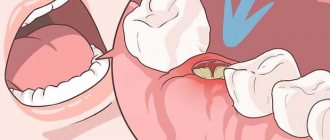23.12.2020 65006
Anyone, sooner or later, may need a tooth extraction. This occurs due to its severe destruction, progression of the inflammatory process and other reasons.
Typically, doctors use removal surgery only as a last resort, when other means are ineffective. It is important to understand that the procedure is a surgical operation that must be carried out carefully and in compliance with all safety requirements.
In this material we will touch on an important issue - the rehabilitation period. We will talk about how long it takes for the gums to heal after tooth extraction, and what rules should be followed to prevent complications from occurring. Compliance with simple safety requirements will not only significantly speed up recovery, but also ensure the safety of your health.
How much does tooth extraction hurt the gums?
Assessing how severe the harm from tooth extraction will be is not always easy. Sometimes removal can take much longer and have a very negative impact on the condition of a person’s gums. And here it doesn’t really matter which doctor performs the procedure - there are many potential complications.
Among the most notable factors of injury are the following:
- Rupture of the ligaments and muscles that hold the tooth. They help the tooth stay inside the socket and not become loose over time.
- Tissue damage. We are talking about both periodontal and periodontal tissues. They can heal for quite a long time.
- Impact on the vascular system and nerves. Serious damage to blood vessels and nerves can usually occur. It is precisely because of the likely contact of blood with pathogenic bacteria during the recovery period that it is important to observe hygiene standards.
When going through the recovery process, you should be prepared for the fact that signs characteristic of inflammation will be observed for some time. In this case, swelling may appear, the temperature of the tissue at the site of removal may increase, and bleeding may occur. Pain also becomes a frequent companion during the recovery period.
In our clinic, removal is performed as carefully and carefully as possible. The extensive experience of doctors allows us to minimize tissue damage and reduce trauma. We will also answer the question of how long it takes for gums to heal and how to properly care for the socket so that it heals as quickly as possible.
Why does a pulled out tooth hurt?
Toothache from removing the “subject of pain” - a damaged tooth - is not supernatural. Tooth extraction is considered a surgical operation according to all medical standards. Damaged living tissue of the gums and oral cavity can cause pain even greater than what the patient experienced from inflammation or decay of a diseased tooth.
Removal of a tooth
Soft tissues are known to have many nerve endings. The gums and mucous membranes are literally riddled with nerves, which, when acted upon, transmit pain impulses to the brain. When the patient receives local anesthesia, the nerve endings temporarily atrophy and cease to fulfill their duties - to carry pain to the body cells. But then the anesthesia ends, and the nerve endings begin to work. Aching, dull pain that interferes with normal life continues, as a normal reaction to surgery.
How normal is this, and how “according to the rules” should a tooth hurt after extraction? Weak. Not too intense. As it fades away. No more than three days. Patients who are particularly sensitive to injury and have a low pain threshold are given four days.
Aching pain can last up to four days
Important! If on the fifth day after tooth extraction the pain in the gums continues and its intensity does not decrease, on the contrary, it increases, you should consult a doctor.
The main stages of socket healing after tooth extraction
It is impossible to clearly predict how long the hole will take to heal. The individual characteristics of the human body, the type of tooth and the characteristics of the operation are of great importance. Typically, it takes more time to restore a hole after the removal of a tooth with a large number of roots and the need for additional manipulations - creating an incision in the gum and others.
In some cases, during the removal process, crumbling and splitting may occur - then the gums will be injured even more.
Conventionally, several main stages of healing can be distinguished:
- Reduced bleeding. Depending on the characteristics of the patient’s body, the gums should stop bleeding after 2-3 hours. Some people take a little longer. If the bleeding does not stop, you should immediately consult a doctor. But this is a rare occurrence unless the patient has problems with blood clotting.
- Formation of a blood clot in the socket. It is very useful because it does not allow bacteria that cause diseases to enter the wound. You cannot remove such a clot - bleeding will open, there is a high risk of inflammation and resumption of bleeding.
- Appearance of a film on the clot. This is a white coating of the epithelium. Gradually it covers more and more space. Between the fourth and seventh day after surgery, the entire clot should turn white.
- Formation of epithelial tissue. Occurs between 20 and 24 days after surgery. The gums from the outside will be the same as next to healthy teeth - color, texture.
When the patient follows the dentist’s instructions and treats the hole carefully, there should be no complications or any problems.
What to do to quickly forget about dental intervention
Very often, upon returning home, the patient continues to feel numbness in part of the jaw. This condition can cause discomfort and even mild aching pain. In order for tissue sensitivity to be restored as quickly as possible, the following rules should be followed:
- On the eve of planned dental procedures, avoid drinking alcohol , fatty and heavy foods. If a specialist recommends taking any medications, it is important to follow his prescription.
- In the case of treating caries , removing tartar, grinding down the top layer of enamel under a crown, it is permissible to massage the gums. You can also drink warm tea or heated water. These simple methods will increase local blood circulation and create conditions for the speedy release of anesthesia. But, if anesthesia was administered before tooth extraction, there should be no talk of any self-massage - touching the hole with your hands is strictly prohibited. Otherwise, you can damage the blood clot that protects the wound from the penetration of bacteria and germs. This will lead to severe inflammation and bleeding.
Don't be alarmed if the anesthetic continues to work for up to six hours. The situation will normalize on its own. If the numbness does not go away longer, this is a reason to consult a dentist again.
Features of the gum restoration process
Sometimes patients wonder if there are any differences in the recovery process, depending on what kind of surgery was performed on the patient. The answer is yes, there are such features. Let's consider three main variants of the situation.
Standard tooth extraction
When a person is healthy, the removal went well, and the tooth itself was not classified as complex, the restoration process begins immediately.
The recovery process takes longer if the tooth was large and a wide wound appears in its place. In this case, the dentist will apply stitches. They last on fabric for 7-8 days, sometimes less or more. Throughout this time, you may feel pain or signs of an inflammatory process.
After 3-4 weeks, most patients experience complete restoration of the gums. The pain goes away, swelling is relieved, and the periodontium heals. Bone tissue begins to form, and from the outside the removal site already looks quite healthy.
Removal before prosthetics
Sometimes tooth extraction may be necessary before prosthetics can be performed. The dentist makes this decision when restoration or the use of special orthopedic structures is impossible.
The removal is done with a view to installing an implant or bridge, which the old tooth will only interfere with. A periosteum augmentation process may also be required. It is more common when teeth are removed from the upper jaw, when there is simply not enough tissue for normal implant placement.
The augmentation procedure significantly increases the recovery time. It is difficult to predict the timing here; you need the attending physician to carefully monitor your condition.
Wisdom tooth removal
The most complex and difficult to predict removal process is wisdom tooth extraction. It is necessary if the tooth grows at the wrong angle, interferes with its neighbors in the dentition, and can cause irritation and other problems.
With this type of operation, the gums can be severely damaged. There are several reasons:
- A large number of roots. They can cause significant damage to your gums during the removal process. Sometimes resection may be required.
- The wisdom tooth is often hidden behind the gum. In this case, an incision will need to be made and exposed before removal can be carried out.
- Often the tooth is located at an angle. He can strongly push against his neighbors. At the same time, the dentist decides how to reduce the pressure and not damage other teeth.
After removal, the gum is not in the best condition and may require stitches. This means that the hole will take longer to heal.
What else can pain indicate?
Severe pain after removal may indicate the development of complications. Pulsating pain that radiates to the ears and submandibular lymph nodes is not normal. The most common causes of complicated postoperative pain are the following factors:
- Violation of treatment protocol. Unfortunately, mistakes do occur, especially in the removal of complex teeth. The techniques and approaches used in different clinics may differ from the standards. Errors include leaving fragments of materials or a splintered tooth root behind.
- Alveolitis. Occurs in the absence of a blood clot. The disease complicates natural healing and interferes with normal tissue regeneration. That is why doctors do not recommend touching the wound with your tongue or rinsing your mouth intensively.
- Dry hole. One of the common complications and the cause of long-term pain after tooth extraction. Despite the moisture of the mucous membranes, bone tissue is visible at the bottom of the wound opening. This problem is typical for smokers during periods of hormonal surges. The doctor seals the wound with a swab containing medication.
- Trigeminal neuritis. Long-term pain persists when a tooth in the mandibular row is removed if the trigeminal nerve is damaged during the manipulation. Damage may be accidental due to structural anomalies or multiple branching of nerve structures.
The likelihood of complications developing is low if the removal protocol, medical recommendations after extraction, and timely response to alarming manifestations are followed.
Reasons for long gum healing
Typically, the answer to the question of why gums take a long time to heal is related to the individual characteristics of the human body, as well as infection.
The addition of a secondary infection can be observed against the background of several common problems:
- The patient violated the requirements for proper gum care. Often the problem lies in the fact that too much caution has been exercised and the quality of oral hygiene has decreased.
- The wound was not properly cleaned. When patients turn to dentists with a low level of skills, there is a high probability that a tooth fragment or a piece of cotton wool will remain in the hole. This can cause serious problems and greatly increase the duration of the recovery process.
- An injury occurred. It is worth watching exactly how you handle the hole. So doctors recommend avoiding any friction, strong pressure and other mechanical irritations.
Any dentist will tell you that removal is best done when the person is completely healthy. Regeneration time may increase if there are diseases of the oral cavity, stomatitis. You should also be wary of sinusitis and sore throat - they can complicate the recovery process.
How to make regeneration faster
To make the recovery period shorter, you should treat the hole as carefully as possible. Several central means help speed up regeneration:
- Brush your teeth correctly. It is important that the oral cavity is cleaned properly and that pathogenic bacteria that can cause inflammation and other problems do not multiply in it.
- Use antiseptics. They need to be rinsed after eating. But from the side of the extracted tooth, you should not rinse your mouth too much, creating a vacuum inside the mouth.
- Try not to put pressure on the gum so that the socket is constantly at rest. Strong mechanical pressure and other similar effects on tissue are especially dangerous.
What to do to make dental anesthesia go away faster
Some patients are interested in: what can be done to make dental anesthesia go faster? Unfortunately, we cannot significantly influence the duration of pain relief after treatment or removal. Experts only recommend waiting a certain period of time. You can check with your attending physician how long the freezing will last in your particular case, since he knows exactly what drug he administered and in what quantity.
It is believed that a warm compress will help speed up the frostbite process after a dental appointment. It dilates blood vessels and promotes the removal of anesthetic. But it is contraindicated in the presence of tissue inflammation, diseases of the oral cavity, and can cause complications. Therefore, you cannot apply a compress without a doctor’s recommendation.
Here are some recommendations on what to do to make jaw numbness go away faster:
- Drink a warm drink (tea, juice) that will start your metabolism;
- Have a small meal or snack;
- Get enough rest;
- Avoid physical activity and going to the gym;
- Refrain from bad habits (smoking, drinking alcohol).
Main treatment methods
Your dentist will tell you what treatment and gum care should be like after tooth extraction. Only he can select the right drugs that are suitable specifically for your case.
Among the most common treatment methods are the following:
- Careful rinsing with preparations and tinctures with various herbal ingredients and antiseptics.
- Local application of soothing ointments and gels.
- Drug treatment. Your doctor may prescribe antibiotics, painkillers, and anti-inflammatory drugs. But we do not recommend using any medications without a prescription.
Methods used in dental practice
How long it takes for the anesthesia effect to disappear depends directly on the method of anesthesia used. The sensitivity of tissues is restored most quickly when using an application. The doctor applies a special gel to the area of upcoming manipulations, which “freezes” for about fifteen minutes.
If the anesthetic medication was administered using a syringe and needle, the area will remain numb for up to one to three hours. The exact time is determined by the location of the treated area, the dose and type of drug.
Can there be complications after tooth extraction?
The issue of complications always worries patients. But if you do not have concomitant infectious diseases, and the operation is performed by an experienced doctor, the risk is very small.
There are several common likely problems:
- Hematoma at the site of removal.
- Severe swelling of the cheek.
- Numbness in the area near the extracted tooth.
- Bleeding.
In some cases, flux may also appear. Dentists should be careful when administering anesthesia. If you do not make sure that the patient does not have an allergic reaction to the drug, you may encounter a number of problems.
How to properly care for your gums
To prevent complications from occurring, you should follow a few simple recommendations:
- Do not heat the gum. Strong heat can stimulate the spread of the inflammatory process.
- Use a soft brush. At the same time, when brushing your teeth, try not to touch the gums at the extraction site.
- Use additional cleaning products. These include irrigators and dental floss.
- Try to use toothpastes with soothing herbal ingredients.
It is very important not to self-medicate. If any problem arises, you should consult a doctor as soon as possible.











